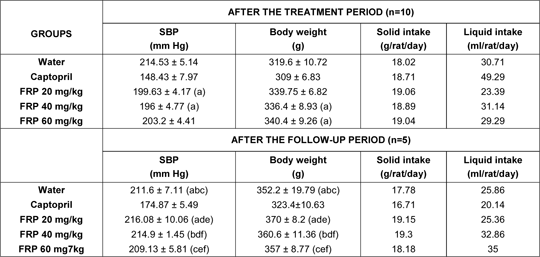Print version
Search Pub Med
Long-term intake of an aqueous seed extract of Fraxinus excelsior L. attenuates the development of hypertension in spontaneously hypertensive rats In a previous study, the acute administration of a Fraxinus excelsior L. seed extract, named FraxiPureTM (FRP), decreased arterial blood pressure in spontaneously hypertensive rats (SHR). The aim of this research was to evaluate the effect of the long-term intake of FRP on the development of hypertension of these animals. After being weaned, male 3-week-old SHR were divided into five groups that were given until the 20th week of life (treatment period) the following drinking fluids: tap water (negative control), FRP 20 mg/kg/day, FRP 40 mg/kg/day, FRP 60 mg/kg/day or Captopril 50 mg/kg/day (positive control). At the end of the treatment period, five 20-week-old rats of each group were sacrificed by decapitation, and the remaining animals from all groups were given tap water from the 20th to 24th week of life (follow-up period). At the end of the follow-up period, the 24-week-old rats were also sacrificed by decapitation. Systolic blood pressure (SBP) was measured weekly in the rats from the 6th to 24th week of life by the tail cuff method. The body weight of the animals was recorded weekly up to the 24th week of life. Daily intake of drinking fluids and freely accessible feed was also estimated weekly in the rats from the different groups throughout the experimental period. The results were analyzed by a one-way or two-way analysis of variance (ANOVA), and differences between the groups were assessed by the Bonferroni test. Development of hypertension was attenuated in the SHR groups treated with Captopril or FRP. The antihypertensive effect was more accentuated in the group treated with Captopril, and it was quite similar in all the FRP groups. Nevertheless, it was paradoxically more accentuated in the groups treated with 20 mg/kg/day or 40 mg/kg/day of FRP than in the group treated with the highest dose of this extract. In addition, solid intake increased somewhat in the FRP groups, and the rats treated with this extract showed an increase in body weight gain. On the contrary, the animals treated with Captopril showed less body weight than the rats of the water group, even if the solid intake in all these animals was similar. The arterial blood pressure increased in the treated SHR when the corresponding antihypertensive treatment was removed. Nevertheless, at 24 weeks of life, systolic blood pressure remained lower in the Captopril group than in the other groups. The body weight of the FRP treated animals returned to control values along the follow-up period. Liquid intake was very variable in all animals but we could appreciate a clear increase in this variable in the Captopril treated rats (see Table 1). Table 1. EXPERIMENTAL DATA OBTAINED IN THE DIFFERENT SHR GROUPS. 
The data of SBP and body weight represent mean values ± SEM and the data of solid and liquid intake are estimated values. Similar letters means no statistical differences (P > 0.05). P estimated by one-way ANOVA. Our results suggest that FRP may be used as a functional food ingredient with antihypertensive activity. Nevertheless, the possible orexigenic effect of FRP should be studied in the future and we are also aware that before routine clinical use of this extract, it would be necessary to carry out clinical studies to demonstrate their long-term antihypertensive efficiency in humans. Supported by a CENIT Project (CEN-20091006).
|

